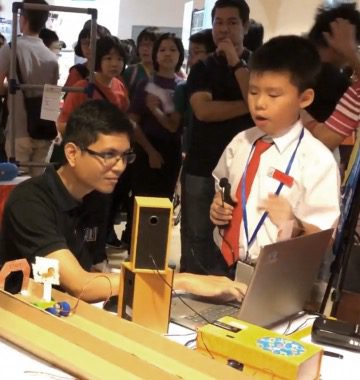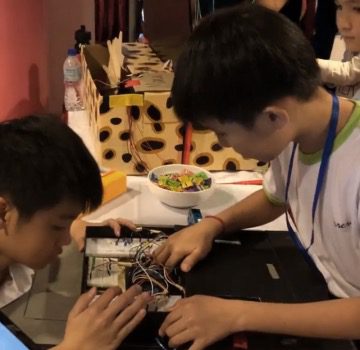THEME

Creating a Game for Positive Change
Create an innovative and immersive game with the intention of addressing the United Nations Sustainable Development Goal – 3 Good Health and Wellbeing in Malaysia.
The aim is to create a game that promotes healthy living and general well-being for all at all ages. You may refer to SDG indicators in Malaysia to help you form your problem statement.
Your game must have creative use of open-source software (e.g Scratch, Python) and optional use of open-source microcontroller (e.g Arduino, Raspberry Pi, Micro:Bit)
SUBMISSION METHOD
Showcase project at State Maker Fair.
PARTICIPANT CRITERIA
- Open to primary schools registered in Malaysia
- Two students per team
- Team members can be from different schools (from the same state)
- 9 years old and above
RULES & REGULATIONS

Teachers’ & Parents’ involvement
We love that parents and teachers take the initiatives to help out with the projects, however, we would also like to remind parents and teachers to remember and allow the kids to own and manage their projects.
We understand that as adults, we tend to think that kids are not capable of many things but we can be wrong most times. Allow them to try and fail and try again. Come alongside to encourage, cheer them on and guide them with their projects. Constantly remind them (and yourself) that they own the project.
Disqualifications
- Team will be disqualified if the project is not according to the Competition Theme.
- Team will be disqualified if the project is not showcased at a Maker Fair.
- Team will be disqualified if members do not meet the Participants Criteria.
CITATIONS
Not everything you have built came from your own idea and it doesn’t have to! We understand that innovation comes in the form of building and improving upon existing ideas. If you have referenced your project from a website or Youtube video, please make sure to mention them in your work.
Let’s show our respect to the hardwork done by the original authors by acknowledging and crediting them. To show your thanks, please include them through citation in your project presentation. Detailed Terms & Conditions can be found here.
JUDGING CRITERIA

The judging criteria for the competition puts a greater emphasis on how well your team express their creativity instead of how well-versed you are technically. You will also need to ensure the games you create are addictive, visually pleasing, and easily understood.
Creativity (25%)
Being creative means the use of imagination or original ideas to create or to invent something. In this competition, creativity can come in many areas in this competition like the game design, the types of recyclable materials, or innovative use of the hardware components.


Communication (30%)
Instead of focusing on the technical aspects of your game, there is a greater weightage on communication because this is an important skill to express your creativity. A clear and interesting presentation is a good indication that your team has thought deeply when developing your game. You will need to explain clearly and interestingly how the game is played during your pitch to the judges.
You will not be penalized for grammatical errors. This is not a language competition. Instead, focus on articulating your game well.
Mechanics (20%)
A good game designer gives his players continuous challenges, where each completed level leads to another more challenging level, to keep them “hooked” on playing a game. You can keep players engaged by setting clear, short-term goals appropriate to the level of the player and to the context within the game.
A well-thought-out game design has a good structure that is often driven by a Game Design Document (GDD). GDD is to unambiguously describe the unique selling points such as the story, characters, user interface (UI), level, sound and music, and gameplay.


Technical (25%)
Under this category, you are required to do a code walkthrough to explain the mechanism of how your game works and how it interfaces with the input and output of the hardware.
Your game must be functioning. Wires need to be well-hidden and not easily disconnected to ensure that your game works and is ready for the judges to try out.
Some games may have an increased element of hardware with minimal software (and vice-versa), but you will not be penalised or judged by the amount of hardware or software in your game.
Get our latest updates, event dates, and competition resources through our e-learning platform.




















